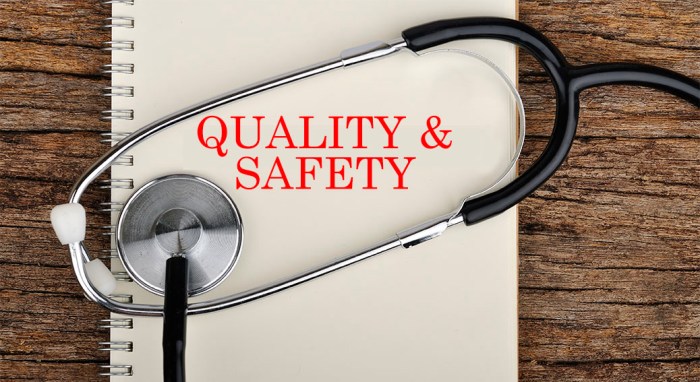
As Patient Safety and Quality Care take the spotlight, this opening passage invites readers into a realm of knowledge, ensuring an engaging and informative experience.
The following paragraph will delve deeper into the intricacies of the topic.
Patient Safety
Patient safety is a critical aspect of healthcare that focuses on preventing errors, injuries, accidents, and other harm to patients during their medical care. Ensuring patient safety is essential for maintaining high-quality healthcare services and promoting positive health outcomes.
Common Patient Safety Issues
- Medication errors: Incorrect dosage, wrong medication, or administration errors can lead to serious harm.
- Healthcare-associated infections: Infections acquired in healthcare settings due to poor infection control practices.
- Falls: Patients may suffer injuries from falls in hospitals or other healthcare facilities.
- Surgical errors: Mistakes during surgery can have severe consequences for patients.
Role of Healthcare Providers
- Healthcare providers play a crucial role in ensuring patient safety by following established protocols and guidelines.
- They must communicate effectively with patients, collaborate with interdisciplinary teams, and prioritize patient well-being.
- Providers should be vigilant for potential risks, report any safety concerns, and actively participate in quality improvement initiatives.
Strategies to Improve Patient Safety
- Implementing electronic health records to reduce errors in documentation and medication management.
- Standardizing procedures and protocols to enhance consistency and reduce variability in care delivery.
- Promoting a culture of safety by encouraging open communication, transparency, and learning from mistakes.
- Engaging patients and families in their care, educating them about safety measures, and involving them in decision-making processes.
Quality Care

Quality care in healthcare refers to the delivery of services that meet the highest standards of safety, effectiveness, patient-centeredness, timeliness, efficiency, and equity. It involves providing patients with the right care, at the right time, in the right way, and in the right setting.Providing quality care to patients is crucial as it not only ensures better health outcomes but also promotes patient satisfaction and trust in the healthcare system.
Quality care leads to improved patient experiences, reduced medical errors, better health outcomes, and overall lower healthcare costs in the long run.
Comparison of Patient Safety and Quality Care Initiatives
Patient safety initiatives primarily focus on preventing harm to patients from medical errors, infections, and other factors during the care process. On the other hand, quality care initiatives aim to ensure that patients receive the best possible care that meets their needs and expectations. While patient safety is a critical component of quality care, quality care encompasses a broader spectrum of factors beyond just safety.
- Both patient safety and quality care initiatives aim to improve patient outcomes and experiences.
- While patient safety focuses on reducing errors and harm, quality care emphasizes providing effective, timely, and patient-centered services.
- Quality care initiatives often involve patient engagement, care coordination, and continuous quality improvement efforts.
Impact of Quality Care on Patient Outcomes
Quality care plays a significant role in determining patient outcomes and overall healthcare quality. When patients receive high-quality care, they are more likely to experience better health outcomes, faster recovery, and improved overall well-being. Quality care also contributes to reducing hospital readmissions, complications, and unnecessary healthcare utilization.
Ensuring quality care is essential for promoting patient safety, enhancing patient satisfaction, and achieving better health outcomes in healthcare settings.
Patient Safety Measures
Patient safety measures are crucial in healthcare settings to ensure the well-being and protection of patients. Various types of measures are implemented to enhance patient safety, utilizing technology, reporting incidents, and continuous monitoring and evaluation.
Types of Patient Safety Measures
- Standard Operating Procedures (SOPs): Establishing clear guidelines and protocols for healthcare staff to follow during patient care processes.
- Medication Reconciliation: Ensuring accurate and safe medication administration by cross-verifying prescriptions and patient records.
- Fall Prevention Programs: Implementing strategies to reduce the risk of patient falls and related injuries within healthcare facilities.
Technology for Enhancing Patient Safety
- Electronic Health Records (EHR): Digitizing patient information to improve access, accuracy, and communication among healthcare providers.
- Barcode Medication Administration (BCMA): Scanning medication barcodes to verify the right medication, dosage, and patient before administration.
- Telehealth Services: Offering remote consultations and monitoring to enhance patient access to care and reduce the risk of infections.
Importance of Reporting Incidents
- Early Detection: Reporting incidents promptly allows for timely intervention and prevention of potential harm to patients.
- Continuous Improvement: Identifying and addressing safety issues leads to the implementation of corrective measures for enhanced patient care.
- Transparency and Accountability: Reporting incidents promotes openness, accountability, and a culture of learning from mistakes to prevent future errors.
Evaluation and Monitoring of Patient Safety Measures
- Quality Indicators: Utilizing specific metrics and benchmarks to assess the effectiveness of patient safety initiatives and identify areas for improvement.
- Root Cause Analysis: Investigating the underlying causes of incidents to prevent their recurrence and enhance patient safety protocols.
- Patient Feedback: Engaging patients in the evaluation process to gather insights on their experiences and perceptions of safety within healthcare settings.
Healthcare Accreditation

Accreditation plays a crucial role in ensuring patient safety and quality care within healthcare settings. It involves a systematic review process to assess and validate that healthcare organizations meet specific quality and safety standards.
Common Accreditation Standards Related to Patient Safety
- Adherence to infection control protocols
- Medication safety procedures
- Patient identification protocols
- Emergency preparedness and response
- Clinical documentation standards
Examples of Healthcare Accreditation Bodies and Their Impact
- The Joint Commission: A leading accreditation organization in the U.S., known for promoting high standards of patient safety and quality care.
- National Accreditation Board for Hospitals & Healthcare Providers (NABH) in India: Focuses on ensuring patient safety through rigorous accreditation standards.
- Australian Council on Healthcare Standards (ACHS): Sets accreditation standards to improve healthcare quality and safety in Australia.
Process of Accreditation and Its Significance
Accreditation involves a thorough evaluation of healthcare facilities based on established standards. This process includes on-site visits, documentation reviews, and interviews to assess compliance. Achieving accreditation signifies that a healthcare organization is committed to maintaining high levels of patient safety and quality care, ultimately benefiting both patients and healthcare providers.
Concluding our discussion, this passage summarizes the key points and leaves readers with a lasting impression of the importance of patient safety and quality care.
Expert Answers
What are some common patient safety issues in healthcare?
Common patient safety issues include medication errors, hospital-acquired infections, and miscommunication among healthcare providers.
How do patient safety measures impact healthcare outcomes?
Patient safety measures help reduce medical errors, improve patient outcomes, and enhance overall quality of care.





